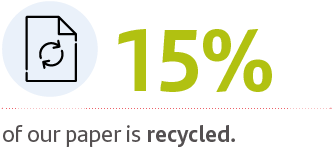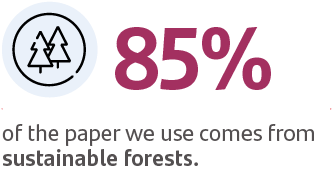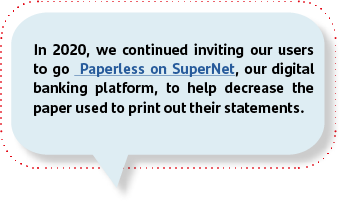footprint
Environmental Management System (SGA)
Our use of natural resources, such as water, paper and energy, is monitored via the Environmental Management System (SGA), which guarantees the responsible use of these resources in all our operations, in addition to the implementation of measures to control the treatment and disposal of waste and emissions.
Through the Santander Environmental Policy, we reaffirm our commitment to:
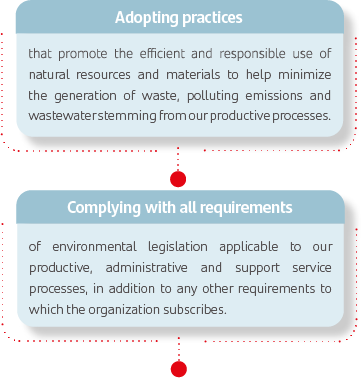
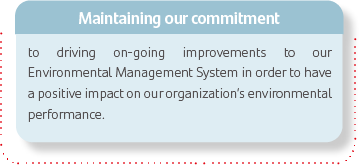
Through our SGA, which is validated by certifications and audit services, we have implemented a range of certifications that underpin our responsible operations:
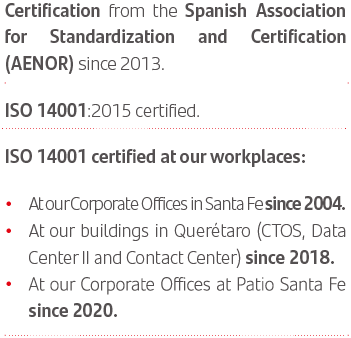
For these certifications to remain valid, an external follow-up audit by AENOR is carried out every year.
ISO 14001: 2015 Environmental Policy
All employees at our corporate facilities in Santa Fe and at Patio Santa Fe have committed to:
- •Adopting practices that promote the efficient and responsible use of natural resources and materials to help minimize the generation of waste, polluting emissions and wastewater.
- •Complying with all environmental legislation applicable to our productive, administrative and support service processes, in addition to any other process.
- •Maintaining our commitment to driving on-going improvements to the organization’s Environmental Management System.
Responsible Internal Operations
As a result of the public health crisis, some of our employees began working from home, which led to a notable decrease in water and energy use, not to mention a drop in the amount of paper and plastic waste generated. During 2020, we implemented a range of actions to mitigate the environmental impact of our operations with regard to emissions, the use of resources, and waste treatment.
It is clear that all of this would not be possible without our employees, who play a key role in guaranteeing the sustainability of our business. This is why we offer environmental awareness activities to promote their active participation.
We offered a compliance course in our Environmental Management System (SGA), which is for all administrative employees working in the metropolitan area of Mexico City at our corporate offices in Santa Fe and at Patio Santa Fe. The goal of this course is to provide them with information about how to generate less waste and decrease the environmental impact of the activities undertaken by the organization.
Emissions
Climate change is one of the major risks facing society, which is why we have focused on streamlining our daily operations to reduce and mitigate the production of Greenhouse Gas (GHG) emissions.
In 2020, total Scope 1 and 2 emissions reached 67,257.50 tCO2e.
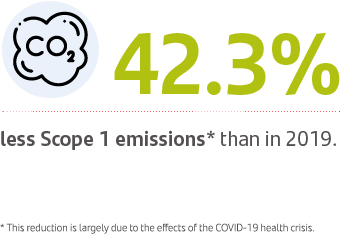
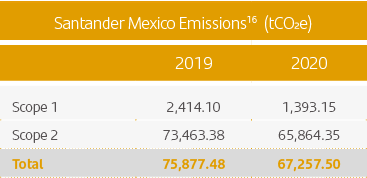
Consumption
Energy Consumption
One of the fundamental issues in helping decrease our environmental impact is energy savings. We have implemented a range of energy use measurement tools to identify areas in which our energy consumption is highest and take the steps necessary to rectify this situation and increase efficiency.
Energy Index Design
To optimize electricity use at our branches, we have implemented an index that is based on the parametrization and regionalization of their electricity consumption. This index measures the annual energy consumption per unit of usable area (kWh per year / useable m2) of each branch, generating energy performance curves and consumption trends. This allows us to identify which branches use the most electricity and apply specific corrective measures.
Use of Clean Energies
We continue redoubling our efforts to implement more actions that involve the use of renewable energy, such as the procurement of alternative energy from SKY EPS, a company that produces energy through efficient cogeneration. In 2020, 70,230,802 kWh of energy was purchased, of which, represent 53% of clean energy within the Bank's total by efficient cogeneration.
Aligned with the Corporate commitment to use 100% renewable energy in our operations, we are analyzing alternatives for purchasing electricity from renewable sources17.
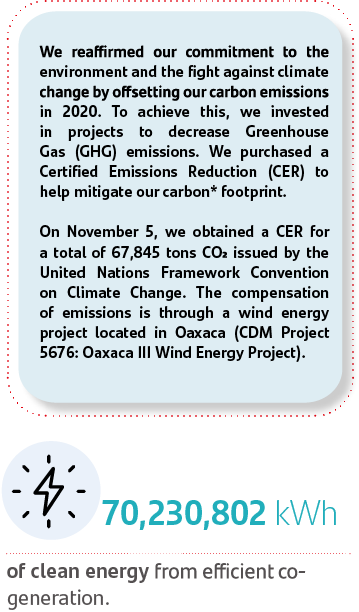
16. The calculation of Greenhouse Gas (GHG) emissions derived from Santander Mexico's activities during 2020 was carried out using the methodology proposed by the GHG Protocol Corporate Accounting and Reporting Standard, the World Resources Institute (WRI) and the World Business Council for Sustainable Development (WBCSD), satisfying the requirements of ISO 14064-1, NMX-SAA-14064 and that stipulated in the Climate Change Law in the area of the National Emissions Registry, in addition to taking into consideration the Calorific Powers published by CONUEE (2020), the Global Warming Potentials defined by the GHG Protocol, and the Emission Factor for the National Electrical Grid for 2020 (CRE). This calculation focuses on operations. The GHG included in this calculation are: carbon dioxide (CO2), nitrous oxide (N2O) and methane (CH4).
17. The project has not yet been developed given changes to federal laws that prevent generators that obtained their permits via the Electrical Energy Public Service Law to incorporate more partners. Until 2020 Santander Mexico does not have renewable energy generation.
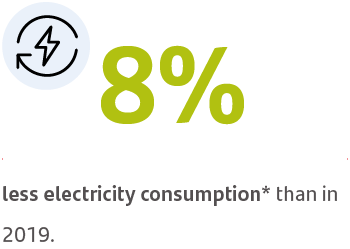
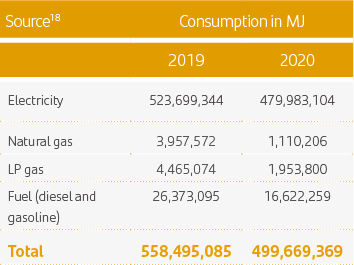
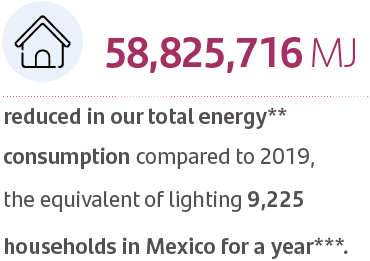
Energy Efficiency
To reduce our energy use, we implemented the following measures:
- • We have automatic lighting control equipment in half of our branches.
- • Lighting and air-conditioning at our Corporate Offices in Santa Fe are time controlled.
** This reduction is largely due to the effects of the COVID-19 health crisis.
***To obtain the equivalence calculation, 2015 data from INEGI and SENER were considered, which can be consulted in: energy consumption in 2015 in the residential, commercial and public sectors (Petajoules). National Energy Balance 2016. SENER https://www.gob.mx/cms/uploads/attachment/file/288692/Balance_Nacional_de_Energ_a_2016__2_.pdf y viviendas particulares habitadas. INEGI 2015 https://www.inegi.org.mx/temas/vivienda/#Informacion_general
18. The consumption of natural gas, LP gas, diesel, fuel and electric energy was calculated based on utility bills, which were converted into MJ using the calorific power published by CONUEE: https://www.gob.mx/cms/uploads/attachment/file/619062/Lista_Combustibles_2021_26feb2021.pdf
Water Use
At Santander Mexico, we believe that protecting the environment reflects an ethical attitude within the company, and we are aware about how we use this resource as a Group, analyzing how we can improve our water use through initiatives that advance our operations and set benchmarks.
This is why we have developed a range of internal communication campaigns to raise awareness among our employees and other stakeholders about the importance of protecting water resources.
Banco Santander Mexico is supplied by the local water network, and for our Corporate Offices in Santa Fe we also use treated water for green areas and restrooms. Wastewater discharge is carried out through the municipal sewage system, in strict compliance with the LMP guidelines stipulated in Mexican environmental law.
Given the sector in which we operate and the characteristics of our products and services, our operations do not have a significant environmental impact on this resource. Furthermore, in our relationship with suppliers and customers, there is no significant environmental impact in terms of water management as a shared resource.
However, we have implemented an Environmental Policy that promotes the efficient use of natural resources and serves as a benchmark to help establish guidelines that allow us to regulate the use and management of these resources in order to avoid environmental impacts and drive sustainable development.
This is why we have an Environmental Management System that is ISO 14001: 2015 certified, allowing us to identify, prioritize and manage environmental risks.
We obtained the certification in this international norm of Environmental Management System in the following facilities:
- • At our Corporate Offices in Santa Fe since 2004.
- • At our buildings in Querétaro -CTOS, Data Center II and Contact Center, since 2018.
- • In 2020, as a new adhesion, the Corporate Offices at Patio Santa Fe were certified.
Furthermore, we have procedures in place to control portable water consumption, the goal of which to restrict the amount of water used in our operational, administrative and service processes undertaken on all our facilities.
The main measures implemented include:
- •Water meter readings.
- •Immediate action for water leaks.
- •On-going monitoring and maintenance of irrigation system (sprinklers and hoses).
- •Routine monitoring of plumbing (kitchen equipment, basins, kitchenettes, W.C./urinals, stopcocks) to detect leaks.
- •During rainy season, the use of rainwater to fill W.C. and urinals.
- •Use of biodegradable cleaning products in the canteen and for cleaning purposes.
- •Installation of motion sensors on faucets, water-saving toilets and waterless urinals.
We monitor our water use based on:
- •Bi-monthly water bills issued by Sistema de Aguas de la Ciudad de México.
- •Weekly visual inspection of pumps.
- •Pump maintenance program.
- •Water use graphs.
During 2020, and as a result of the public health crisis, the total amountofwaterweused decreased from 461,258.75 m3 in 2019 to 336,446.48m3, 27% less in a year-on-year comparison.
315 m3 came from treated water supplied to our Santa Fe Corporate Offices in CDMX, 120,948m3 from water tankers, and 215,183.48m3 from the local water supply.


Paper Use
To guarantee the sustainable future we all want, we need to take the amount of paper we use into account. This is why we have implemented sustainable guidelines for the procurement of this resource, in addition to coordinating internal paperless campaigns to ensure our employees only print what is truly necessary, in addition to recycling paper and promoting double-sided printing.
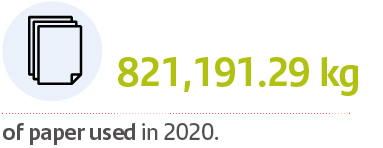
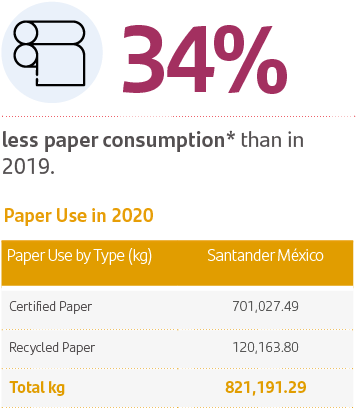
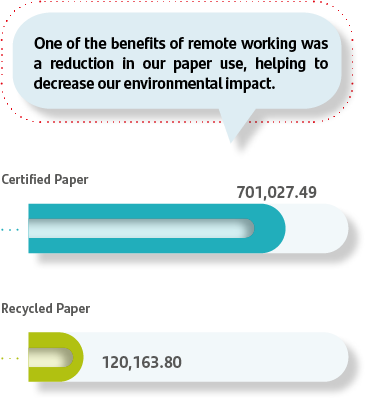
Waste Management
We have implemented a number of internal campaigns to raise awareness among out employees of the importance of separating waste at our offices. We have successfully separated waste from the source to help decrease disposal in landfills. Furthermore, our facility servicing suppliers separate and classify all waste. Once classified, they are then transported for recycling or disposal.
Reduction of Single-Use Plastics
As a major part of our environmental goals, we are aligned with the Santander Global initiative to eliminate the use of unnecessary single-use plastic at all of our offices by 2021.
In 2020, our Corporate Offices in Santa Fe became ISO 14001 certified; this means that, as a measure to help protect the environment, we eliminated plastic items, substituting them with biodegradable materials. We focused on the following activities:

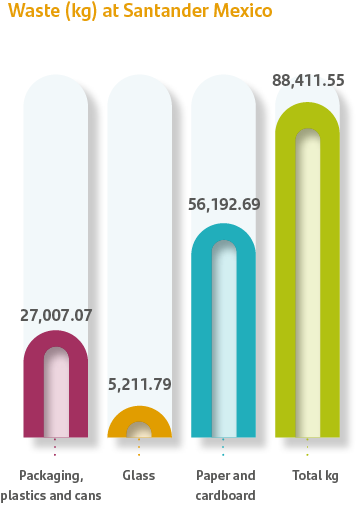
We are also working to ensure these same environmentally friendly measures are adopted at Patio Santa Fe.
In 2020, we reached 83% compliance with our goal to eliminate plastics, through initiatives such as:
- •Including products whose packaging is not made from single-use plastics.
- •Banning single-use plastic products from our buildings.
- •Incentivizing refills in the cafeteria.
- •Restricting the sale of bottled water in buildings and using biodegradable packaging in canteens.
- •Replacing bottled water in meeting rooms with jugs of water.
- •Promoting the installation of filters and drinking fountains, in addition to implementing a maintenance system for existing infrastructure.
- •Eliminating plastic packaging from vending machines.
- •Replacing the plastic boxes used to store business cards with a recycled cardboard one.
Suppliers
To meet our sustainable goals, it is of the utmost importance that we are supported by our value chain. In order to work with us, suppliers must be aligned with our values and ethical, legal, social, environmental and economic criteria. This means that, in the contract, they must reaffirm their commitment to establishing a regulatory framework and processes to help protect the environment, including:
- •Training for the employees of our suppliers covering environmental management and awareness materials provided by Grupo Santander.
- •Implementation, execution and maintenance of the order and cleanliness program focusing on sorting, setting in order, shining, standardizing and sustaining (5S).
- • Benchmarks for the use of potable water, detergents, cleaning supplies, hazardous materials, among others.
When entering into a contract with Santander Mexico, our suppliers, except those who are exempt, reaffirm their commitment to the Corporate Social Responsibility clause and the principles of the United Nation’s Global Compact:
- • Human Rights
- • Workplace Standards:
- » Respect for the freedom of association, the elimination of forced or compulsory labor, the abolition of child labor, and the elimination of discrimination in respect of employment and occupation.
- • Environment:
- » Promotion of employer responsibility.
- » Implementation of environmentally-friendly technologies.
- • Fight against Corruption:
- » Prevention of extortion and bribery.
In the contracts and agreements we enter into with our suppliers, we have decreased environmental impacts and reduced risks by incorporating quality, environmental management, workplace relations, risk prevention, and corporate responsibility indicators. In 2020, we had:
Aquanima
Aquanima is our procurement hub, and, alongside the Banks Comprehensive Expense Management area, it is tasked with defining, monitoring and evaluating procurement and third- party payment processes. It also includes a risk management area, the Vendor Risk Assessment Center (VRAC), which coordinates the application of surveys regarding the level of commitment of our suppliers in the areas of Human Rights, the Environment, Social Responsibility and Sustainability.
As part of this process, suppliers are asked if they are certified areas such as quality, environmental management, workplace relations, occupational risk prevention and corporate social responsibility, among others. They are then asked to send evidence to assess their compliance in these areas prior to making the final selection.
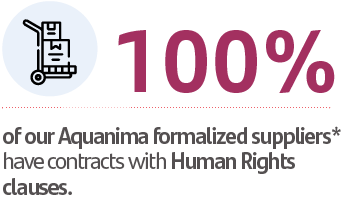
All suppliers understand the General Code of Conduct. Furthermore, an annual assessment is undertaken by VRAC, in which suppliers answer a questionnaire about the Code of Conduct or Ethics, anti-corruption measures, data protection, channels available for the reporting of suspicious activities, and compliance or control programs, among others. This information is requested to ascertain the supplier’s levels of compliance, which, in turn, is used to determine whether they can become a Santander supplier or not.
* 519 formalized by Aquanima in 2020.Throughout 2020, a number of measures were implemented to continue improving operations:
Training
For the first time, training was offered to suppliers who were not regularly aligned with Responsible Banking measures. Training days were organized, during which information about the following issues was presented:
- • The importance of Sustainability within companies.
- • What is Corporate Social Responsibility?
- • Advantages of being a Socially Responsible Company.
- • How to integrate the Principles of the Global Compact and the UN Sustainable Development Goals into companies.
- • What is a Code of Conduct and what should it cover?
- • ISO Standards (14001, 26000 and 45000).
Aquanima activities during the COVID-19 pandemic
Aquanima has worked alongside the Bank to tackle COVID-19. Thousands of man hours have been invested in the following actions:
Hygiene Supplies
To ensure the continuity of our operations, since the pandemic began we have been working to source essential supplies, such as facemasks, gel, gloves and sanitizing wipes, in addition to special products and services.
COVID-19 Tests
We have researched and directly contacted manufacturers from China and other countries to source COVID-19 tests.
Sustainable Financing and ESG Risk Assessment
To drive inclusive and sustainable development in the country, we support projects and works by offering loans that are underpinned by sustainable guidelines. To do so, we analyze the risks of these financial projects based on Environmental, Social and Governance criteria (ESG), ensuring strict compliance with the Equator Principles.
Outsourcing and Supplier Management Model
This model encompasses the use of risk calculators to identify relevant and critical services, which are fed into an inventory for monitoring and control purposes. This allows us to evaluate suppliers to ensure that they meet requirements in the areas of data management, business continuity plans for support services involved in critical processes, and follow-up measures for service level agreements, among others, in addition to implementing measures opportunely.
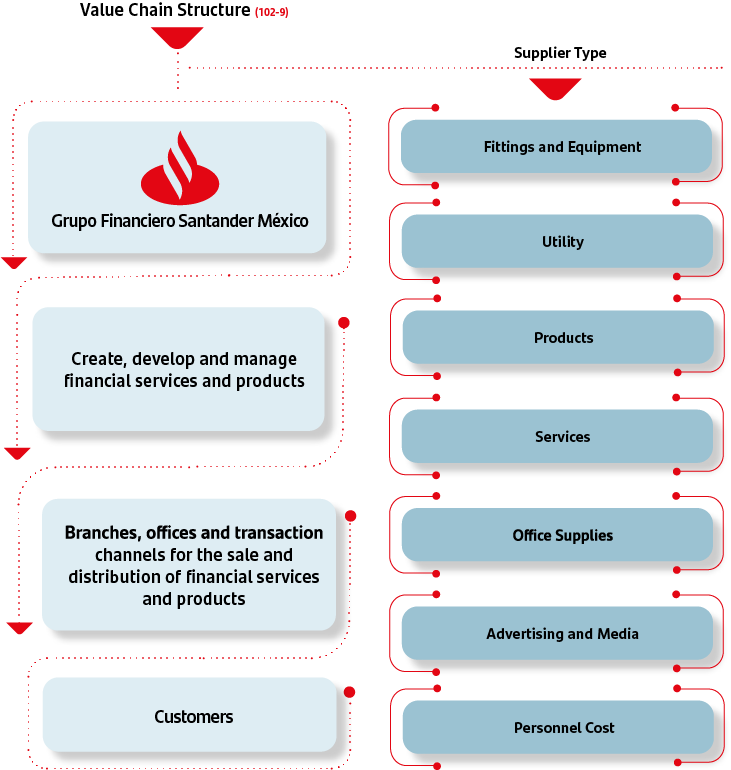
Assessment of Social and Environmental Risks
Our General Sustainability Policy establishes that we respect the best international practices in social and environmental matters, specifically the Equator Principles. Any project that exceeds ten million dollars (USD) must comply with the Equator Principles.
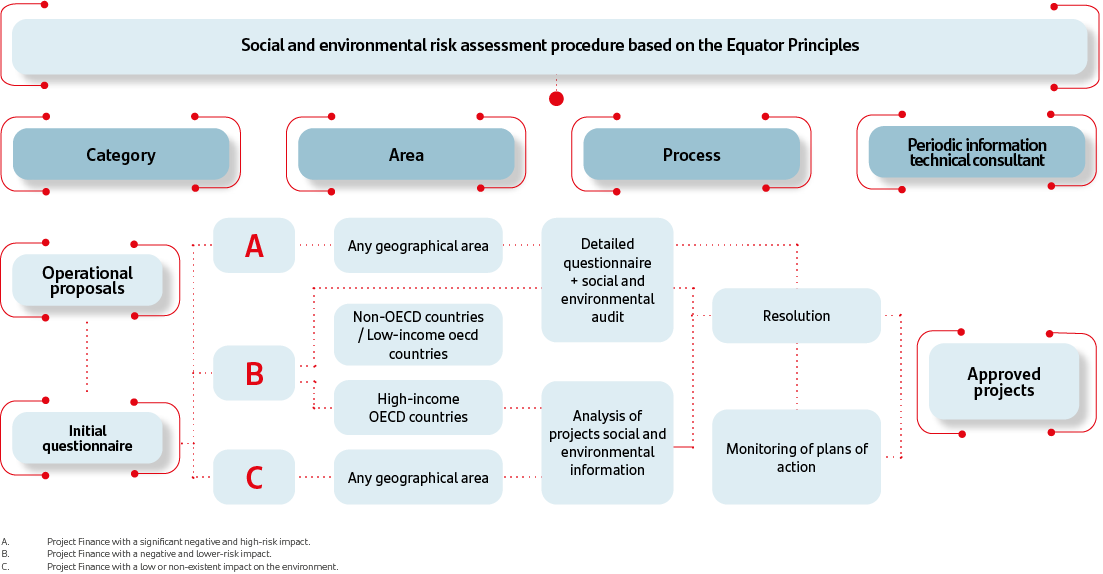

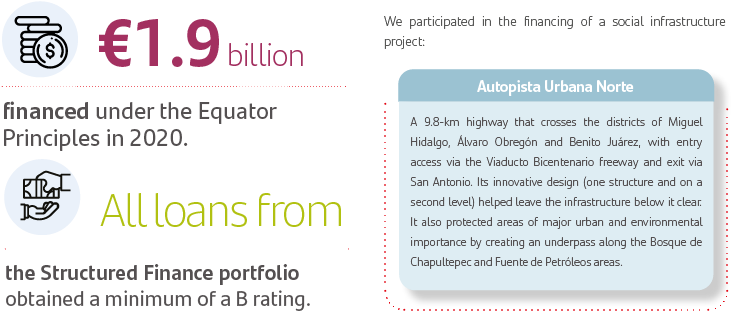
Social and Environmental Risk Policies
Our Environmental, Social and Climate Change Risk Management Policy establishes the Santander Group's criteria in relation to investment in entities, the provision of financial products or services in the oil and gas sectors, electricity generation and mining and metallurgy, as well as such as derivatives of “soft commodities” businesses. The policy establishes criteria for the identification, evaluation, monitoring and management of environmental and social risks and other activities related to climate change based on the precautionary principle. This policy defines specific activities that Grupo Santander does not finance, for example new customers with coal-powered power plants, or new thermal coal projects or customers.
In line with the criteria stipulated in this policy, we evaluate our loans and any other financial products or services, such as debt, insurance, consultancy services, equity and asset management.
The process to analysis social and environmental risks is divided into three stages:
- 1. Compiling and submission of information.
- 2. Assessment of social and environmental risks.
- 3. Integration of credit risk into the workflow.
Furthermore, our Defense Sector policy stipulates that all operations in which we are involved relating to the manufacturing, sale or distribution of defense material or dual-use technologies must be assessed to determine the existence of any risks that could be deemed to be a threat to the peace, defense and stability of certain countries, in addition to causing serious economic or environmental damage.
We focus on analyzing the following risks:
- •Whether the goods could provoke or aggravate armed conflicts or increase existing tensions within the country of final destination.
- •Whether there is a risk to the security, peace, defense and stability of the countries in question.
- •Whether there are serious reasons to believe that the product could be deviated from its destination.
- •Whether the product being financed could be used to attack another country or lead to a forceable territorial claim, taking into account the country in question’s attitude toward terrorism, the nature of its alliance and its respect for international law.
In accordance with values and principles that are based on the respect for Human Rights and in the interest of employees, customers, shareholders and society in general, we are committed to not being involved in any operations with companies that manufacture, sell or distribute the following prohibited materials:
- •Anti-personnel mines.
- •Cluster ammunition.
- •Chemical or biological weapons.
- •Nuclear weapons.
- •Ammunition that contains depleted uranium.

